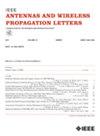Design of Miniaturized Conformal Rasorber Using Machine Learning for Precision Intrusion Mitigation
IF 4.8
2区 计算机科学
Q2 ENGINEERING, ELECTRICAL & ELECTRONIC
引用次数: 0
Abstract
This letter introduces a miniaturized conformal single-layer frequency selective rasorber (FSR) optimized for A-A-T-A-A mode operation for precision intrusion mitigation. The designed FSR has a back-to-back arrangement to achieve absorption and transmission properties. Machine learning (ML) algorithms are used to optimize FSR designs and reduce computational time. The preliminary geometrical parameters from proposed FSR obtained from full-wave electromagnetic solver are used to train the ML model. The K-nearest neighbor (KNN), and multiple linear regression (MLR) algorithm utilized in this research works efficiently with a small mean square error (MSE) varying between 0.01 and 0.09. Furthermore, the MLR offers the highest correlation (基于机器学习的小型化保形反射器精确入侵防御设计
这封信介绍了一种小型化的共形单层频率选择反射器(FSR),针对精确入侵缓解的a - a - t - a模式操作进行了优化。设计的FSR具有背靠背的排列,以实现吸收和传输性能。机器学习(ML)算法用于优化FSR设计并减少计算时间。利用全波电磁求解器得到的FSR的初步几何参数对ML模型进行训练。本研究采用的k最近邻(KNN)和多元线性回归(MLR)算法具有较高的效率,均方误差(MSE)在0.01 ~ 0.09之间。此外,MLR提供了最高的相关性(${{R}^2})$值0.99。利用ML技术优化的FSR具有0.17λo的小型化尺寸,并提供四倍吸收频段,即6.9 GHz (f1), 10.9 GHz (f2), 18.3 GHz (f3)和20.8 GHz (f4),用于精确入侵缓解。FSR提供14.6 GHz到15.7 GHz的传输特性(根据FCC标准)。由于其保形设计,所提出的a - a - t - a FSR是国防环境中雷达系统的理想解决方案。
本文章由计算机程序翻译,如有差异,请以英文原文为准。
求助全文
约1分钟内获得全文
求助全文
来源期刊
CiteScore
8.00
自引率
9.50%
发文量
529
审稿时长
1.0 months
期刊介绍:
IEEE Antennas and Wireless Propagation Letters (AWP Letters) is devoted to the rapid electronic publication of short manuscripts in the technical areas of Antennas and Wireless Propagation. These are areas of competence for the IEEE Antennas and Propagation Society (AP-S). AWPL aims to be one of the "fastest" journals among IEEE publications. This means that for papers that are eventually accepted, it is intended that an author may expect his or her paper to appear in IEEE Xplore, on average, around two months after submission.

 求助内容:
求助内容: 应助结果提醒方式:
应助结果提醒方式:


